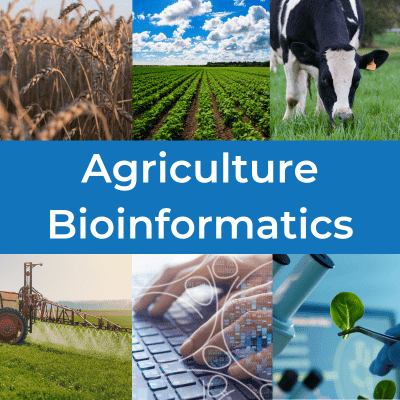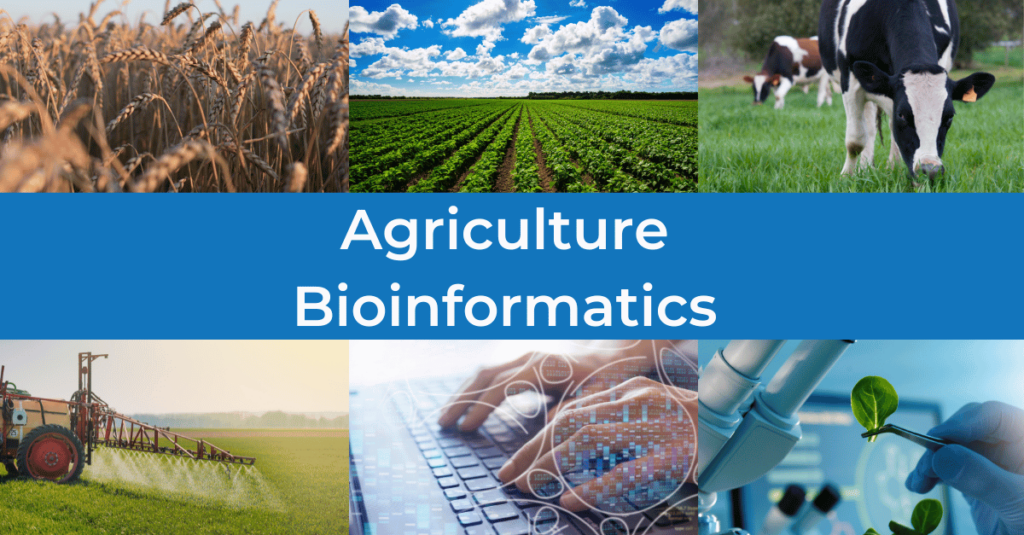Agriculture Bioinformatics: Advancing Agriculture Research
- 1st September 2023
- Posted by: Breige McBride
- Category: Bioinformatics

Agriculture bioinformatics refers to the use of computational tools and techniques to analyse biological data related to agriculture. The findings from such analyses can be used to improve crops, livestock and agricultural processes. If your research focuses on agriculture, agriculture bioinformatics has the potential to enhance the effectiveness of your research across different research stages, including:
- When planning a project or experiment, bioinformatics can help to eliminate potential sources of bias.
- During experiments, bioinformatics can allow you to optimise protocols and give you real-time feedback on your experiments.
- Once experiments are complete, bioinformatics can help suitably analyse your data.
- Once your study has been completed, often a post-hoc bioinformatics analysis can provide new insights into your results and conclusions.
- Artificial intelligence (AI) or machine-learning-based workflows can offer further value throughout a project.
In summary, it is never too early or late to involve bioinformatics in your study as it can help throughout the life cycle of a project.

Providing Solutions to Common Problems
It is possible to apply agriculture bioinformatics to any and every area of agricultural research, including but not limited to:
- Crop research
- Herbicides
- GM crops & plant biotechnology
- Soil improvement
- Resistance to stress & pathogens
- Microorganism identification
- Gene and protein function
- Livestock
Fios Genomics can provide bespoke solutions to various common problems including handling genetic sequencing data such as whole exome sequencing (WES), whole genome sequencing (WGS), genotyping and identification of genetic variants, detecting genetic associations, molecular subtyping and phylogenetics.
In addition to our genetic analyses, we can perform gene expression analysis and transcriptional profiling/transcriptomics using next-generation sequencing (NGS) platforms to determine gene expression associations with phenotypes or traits of interest, and we can identify gene expression biomarkers.
Our microbiome analyses are particularly popular with our client base and can define microorganism composition in, for example, soil or livestock samples.
Finally, we can utilise state-of-the-art machine learning approaches to enhance predictions and decision-making. What’s more, we are entirely data-driven, and we tailor our approaches to best suit the data provided to us. Our analysis pipelines follow relevant best practice guidelines.
Key Publications in Agriculture Bioinformatics
The recent advances in AI, which have impacted every industry, of course, offer opportunities to enhance agriculture bioinformatics and research. As noted in a recent Correspondence article in Nature Biotechnology, AI could be used to help select traits preferred by consumers to guide breeding, in order to catalog phenotypes in large populations, select suitable parents for breeding (including using algorithms to maintain genetic diversity), and in predictive breeding, all with the ultimate aim of improving crop and livestock fitness (Hayes, et al., Nature Biotechnology, 2023).
Many of the benefits and applications of using NGS in agriculture research are described in a previously published review on the topic. Notably, the authors of this review suggested that “Suitable computational methods and appropriate resources are fundamental for detecting value added biological information providing novel insights into the organization of biological systems.” which neatly summarises the contribution of bioinformatics to data analysis (Esposito, et al., Chemical and Biological Technologies in Agriculture, 2016).
Our Agriculture Bioinformatics Collaborations
Fios Genomics have collaborated on numerous agriculture bioinformatics projects in recent years. Most of these are confidential but some of our work has been published in peer-reviewed journals which are publicly available. In fact, further information on each of these collaborations is available on our website or via the following links to the publications:
Freeman, et al., A gene expression atlas of the domestic pig. BMC Biology, 2012.
Pickering et al., An intrinsic cell cycle timer terminates limb bud outgrowth. eLife, 2018.
Author: Colin Shepherd, Scientific Editor, Fios Genomics
Sources
Hayes et al., Nature Biotechnology, 2023: https://www.nature.com/articles/s41587-023-01898-2
Esposito, et al., Chemical and Biological Technologies in Agriculture, 2016: https://chembioagro.springeropen.com/articles/10.1186/s40538-016-0054-8
https://emea.illumina.com/areas-of-interest/agrigenomics.html
Leave a Reply
You must be logged in to post a comment.

